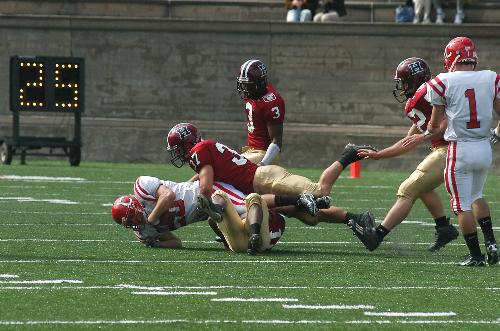
Though the defensive line and linebacking core—led by captain Ryan Tully, center—have stopped the run, opponents have found success airing the ball out against senior Daniel Tanner and the rest of the Crimson secondary.
Despite all the changes, injuries, and controversies, the Crimson has opened the season 4-0, soundly defeating league nemesis Brown and avenging last year’s losses to Cornell and Lehigh. They’ve shown that they can come back—they’ve trailed in three of the four games, including falling behind by 17 at Lehigh—and that they can win while they’re ahead, after holding off Brown and Cornell late.
Harvard, already the preseason favorite to win the Ivy League, will not be an underdog for the rest of the season. So it was only natural yesterday that coach Tim Murphy was asked how good his team potentially could be.
“Well, it’s a good question,” Murphy admitted. “Personally, right now I think we have a lot of areas we need to improve.” He echoed this sentiment at least four separate times after Saturday’s game.
“We need to be a better finishing team,” Murphy said. “We need to improve our pass defense, we need to improve our consistency. Right now I think we have a lot more room for improvement than I would like.”
But even Murphy could not resist comparing certain elements of the 2006 Crimson to some of his great teams of the past.
“This is probably the most tackles for loss we’ve had at this stage in the game since we’ve been here, or maybe since the ’97 team,” said Murphy, referring to the squad led by star linebacker Isaiah Kacyvenski that went 9-1 and won the Ivy League championship.
Murphy is guarding against overconfidence, and rightly so. Harvard has been outscored 50-41 in the second half this season, including a 36-7 opponent advantage in the fourth quarter. The fact that Harvard has held big second-half leads in most of those games seems to be little consolation.
“We played a terrific half of football, but we kind of limped in for a variety of reasons,” Murphy said.
“There are no excuses,” he added. “Regardless of being up 20 points, we’ve got to play better as a team for four quarters.”
Another consequence of Harvard’s large early leads is that teams have been forced to throw the ball more in comeback bids, a partial explanation for opponents’ 285.8 passing yards per game so far. But on Saturday, Cornell had plenty of success with four and five wide receiver looks early in the game against Harvard, gaining 61 yards on four pass plays on the Big Red’s game-opening six-play touchdown drive.
Cornell sophomore quarterback Nathan Ford had a career day, throwing for 309 yards, which came a week after Lehigh quarterback Sedale Threatt had a career day of his own with 293 yards on just 19 completions.
“As well as we’re playing the run, we need to improve our pass defense,” Murphy said. “It’s put a lot of mileage into offenses the last two weeks.”
But there remained plenty of outward signs of Harvard’s league dominance.
“They’ve proven to be the class of the league,” Cornell coach Jim Knowles said. “They’re as good as any team I’ve been around in the Ivy League.”
And, as Knowles pointed out, the Crimson boasts tremendous depth at key positions. Senior running back Clifton Dawson is the obvious strength, but an offensive line that has cleared holes and given the quarterbacks time has been equally important. Junior quarterback Chris Pizzotti has been excellent in his three starts, just like sophomore Jeff Witt was during a brief stint. Pizzotti completed passes to nine receivers but didn’t hit sophomore Alex Breaux or freshman Matt Luft, two key options in the first three games.
Certainly no one is confusing this outfit with the 2004 team that cruised to an Ivy League title (with the exception of Dartmouth and the first half against Brown that season). But this year’s edition of the Crimson has already weathered controversy and gotten off the quarterback merry-go-round for the time being. If Harvard can improve in key areas as the meat of the Ivy schedule approaches, the team will only widen the gap between itself and the field.
—Staff writer Brad Hinshelwood can be reached at bhinshel@fas.harvard.edu.
Read more in Sports
NOTEBOOK: D-Line Staggers Versus Penn












